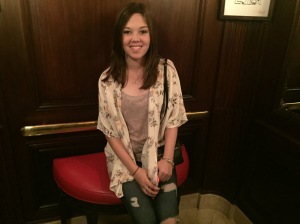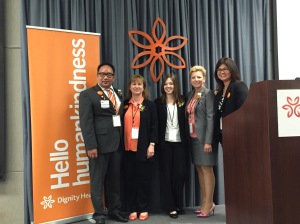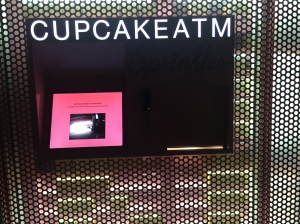I was interviewed by Danny van Leeuwen for his Health Hats blog. I wanted to share the interview here. Thanks Danny for interviewing me about my thoughts on transitioning to adult healthcare, on how to change healthcare, and my thoughts on advocating for myself and others! It was fun.
Category: Uncategorized
No Wonder Healthcare Is So Expensive!
I am thinking that we might really need to just burn the healthcare system to the ground and completely start over.
Although I am pretty experienced with healthcare, the financial piece is one that I haven’t really been as involved in since I am still on my parent’s insurance and they pay the bills. Knowing that I can’t do that forever, I have been starting to pay more attention. Last weekend, I was home in Tampa, and my mom was muttering something about our new insurance and the bill. So, I decided to take the opportunity to learn more. I don’t know if others know how this all works, but I didn’t, so I am going to explain what I learned. Brace yourselves. It’s ridiculous.
Due to my rare disease, I get two infusions in the hospital each month. I am admitted to the hospital for about 23 hours. It is the same treatment every single month. Exactly the same. Every once in a while I might need more meds for nausea or an extra lab test or something minor, but essentially it is always exactly the same.
Hospitals (and doctors in general) create this thing called a Chargemaster that has the rate for every procedure or group of procedures that they bill insurance companies and self-pay patients. Medicare has standard rates for all procedures, however those rates get increased in some areas because they are more expensive areas, such as New York or San Francisco. However, these rates are all based on a base payment and just adjusted for the city. But, the hospital knows that some insurance companies will pay more than others and they don’t want to limit their payment if someone will pay more, so they jack up the rate that they bill for everyone. So, let’s say Medicare will pay $100 for something like a Chest X-Ray. Well, Cigna might pay $150, Blue Cross might pay $135, Aetna might pay $200, and some insurance company that they don’t have a contract with might pay $300. So, the hospital makes the rate something like $700 to be absolutely sure that they charge more than the highest possible amount someone might pay. Then, they write off the $500 difference between the $700 and the $200 for Aetna, and the $400 for the insurance company that they don’t have a contract with. The self-pay patient has to negotiate with the hospital, and hopefully they get a rate at least 25 -50% of the $700. But there is no requirement for the hospital to have a self-pay rate that is any specific rate.
So, what freaked my mom and I out this weekend is the difference that my hospital was paid for the EXACT same medications, with the EXACT same doctor, at the EXACT same hospital with the EXACT same nurses. I have had three insurance companies in the last 12 months. The pictures and table below show what they have paid at the same hospital and treatment.
| Insurance Company | Rate Charged | Amount Written Off | Amount the Hospital Received |
| GEHA (Aetna Contract) | $28,405.99 | $7,669.62 | $20,736.37* |
| Blue Cross Alabama | $29,756.15 | $25,930.71 | $3,827.45 |
| Cigna | $28,755.17 | $25,436.17 | $3,319.00** |
*$4,260.90 was what I (the patient) had to pay ** $221.82 was what I had to pay
The difference in cost to the system is $202,907.04 a year just for me!
I understand the value of having negotiated rates, and I get that insurance companies can argue that they bring patients or offer some other competitive reason for the hospital to give them a discount. BCBS and Cigna were fairly close with about $500 difference or 13%. However, I cannot possibly imagine how one insurance company has to pay 5.41 times more for the exact same thing! Literally over $16,000 more!!
So after all this you might be wondering how why does this really matter to me if it only makes the insurance companies pay more in some cases? This is actually one of the biggest causes of heath care being so expensive because the insurance company paying more means that your family will need to pay more in premiums and in out of pocket expenses. NO WONDER HEALTH CARE IS SO EXPENSIVE.
But wait… there’s more.
So, I asked my mom to get me some more examples. My dad started searching through the millions of Explanation of Benefit or EOB files we have (by the way, why are these still sent by paper??). These EOB reports are what explain this whole system of what was billed, what is allowed by the insurance company contract, what the insurance company is paying, and how much the patient owes.
Over the years, I have had this exact same treatment now at three different hospitals and with multiple different insurance companies. I wanted to see how much these vary. These additional ones are shown in pictures and the table below.
| Hospital | Insurance Company | Rate Charged | Amount Written Off | Amount the Hospital Received |
| EAMC | GEHA (Aetna Contract) | $28,405.99 | $7,669.62 | $20,736.37* |
| EAMC | Blue Cross Alabama | $29,756.15 | $25,930.71 | $3,827.45 |
| EAMC | Cigna | $28,755.17 | $25,436.17 | $3,319.00** |
| FHWC | Cigna | $47,171.56 | $29,435.05 | $17,736.51 |
| ACH | Cigna | $19,491 | $9745.98 | $9745.95 |
| ACH | Blue Cross North Carolina | $18,279 | $8,832.23 | $9,447.79 |
I know it is a lot of numbers, and it has been mind-blowing to me. So, just to make sure we are all on the same page.
- I had the exact same Cigna plan for three different hospitals. The charges for the same infusion at the three hospitals were $28,755, $47,171, and 19,491. I never knew that it was that different.
- The reimbursement from the SAME insurance company for three different hospitals was $3,319, $17,736, and $9,745. I never knew that picking a different hospital could make THAT much of a difference. In fact, the cheapest one is where I have felt I have gotten the best care, had the best nurses, and had the least amount of complications.
- The reimbursements overall ranged from $3,319 to $20,736. How is that possible? Why do we allow this?
- Two different Blue Cross Plans paid drastically different amounts – $3,827 to $9,447. I would have thought they would be similar since they are both Blue Cross?
The thing that has me wondering the most is how can we help patients understand this? How can we choose hospitals that have the best rate AND the great quality? In my case, I think the lowest price is actually also the best quality, but it could have been that the lowest reimbursement was lower quality. How can we help people evaluate this? How can we get the difference in fees to be lower? Maybe everyone should post their bills? Can we require hospitals or insurance companies to publish their rates?
I have seen on twitter that hospitals had to post their prices. I went looking at these three hospitals but I couldn’t figure out the charges. Even if I had, I would have thought All Children’s (ACH) was the best deal because it had the lowest actual charge, but the reimbursement rates in their contracts were actually higher.
I am starting to understand the basics of why the financials of our healthcare system are such a mess. I have focused on improving the patient experience, keeping patients safe, and improving treatment options that are available. I guess now I need to learn more about the financial aspect of health care. And just from researching this in one day, I can already tell that it is just as messed up as the rest of the health care system.
I wish there was an easy to use app that would let me compare prices and quality so that I could easily make a decision on where to go. Instead, I have to attempt to decipher what the vague numbers on the hospitals website actually mean and try to guess which insurance company pays the best rate to the hospital. Surely we can do better. We must do better.
I am sure there is a lot I don’t know. Please share comments!
Family Centered Rounds – Published!
Life has been so busy that I didn’t even realize my first official published article was posted! I was asked to review a published study about family centered rounds for the Hospital Pediatrics journal. My original pediatric hospital did some form of family centered rounds even when I was diagnosed in 2010, so I haven’t really known the healthcare world without it. I have found some benefits and some frustrations with it, so I was very interested in the study found here.
The results published were very interesting.
“RESULTS: Thirty rounding sessions involving 234 encounters of FCR over a 12-week period were analyzed. On average, teams spent 7 minutes in each patient room and approximately the same amount of time outside of the room. Attending physicians were the dominant medical speakers during rounds (30.8%), and nurses spoke the least (2%). When inside a patient room, there was no significant difference between the percentage of time that attending physicians spoke (25.6%) and that of families and patients (23.0%). The surveys revealed that the medical team consistently underestimated the percentage of time attending physicians talked and desired attending physicians to talk less. They also overestimated the time spent in the patient rooms, the time families talked, and nurse presence during rounds and desired an increase in each of these areas.” Pickel et al
The best part was in the Conclusion:
“Medical teams believe and desire that attending physicians talk less and families and nurses talk more than observations reveal.” Pickel et al
My discussion article that was also published in Hospital Pediatrics can be found here.
I obviously am all for more collaboration with patients, and I highlighted that in my conclusion. I am excited to see this type of study taking place.
“One example that would be great is having a truly patient-centered rounding system to evaluate whether it is possible to include all providers and family in rounds at 1 time and then assess whether it makes a significant difference in patient experience or outcomes. We would also like to see a study examining whether waking patients up early for rounds affects their participation and outcomes compared with letting them wake up naturally. Another valuable study would be to evaluate the perceptions of the patient on the rounding process compared with the perceptions of the providers and nurses on discharge. This study provides a great model for additional understanding, and we hope to see more like it in the future.” – Morgan Gleason and Amy Gleason
How would you like to see collaboration and family rounding happen?
Radio Interview with Pat Rullo
Last week, I was interviewed by Pat Rullo for the Those Radio Kids show. Pat and I met at the Cleveland Clinic Patient Experience Summit, and she previously interviewed me for her Speak Up and Stay Alive radio show. She does great work, so I was excited to speak with her again. She is doing a great show to help kids and teens who have chronic health issues. We spoke a little about my journey, things I have found effective, and advice that I would have for other kids and teens with chronic disease. She is also interested in talking to other young people with chronic disease so let me know if you are interested! Otherwise, don’t be shy. Let me know what you think of the interview and share any tips you might have for others as well.
http://www.thoseradiokids.com/morgan-gleason/
Here is a picture of Pat and I two years ago at the Cleveland Clinic.

Time with Family
I think I feel my best when I get to spend time with my family. I got to spend a nice break with my grandfather, parents, siblings, uncles, aunt, and my dog. We relaxed, laughed, and had a boat parade for the 4th of July. My family is always watching to see if I am feeling ok, and they are always thinking ahead to keep me out of the sun or to make sure we aren’t doing something that would make me feel worse. It is nice to have such a supportive family. When do you feel your best?
I also got to go with my mom to the White House where she won an award for being a Champion of Change for Precision Medicine. It was so great to see her get such an honor, and I am so proud of her! Here is her blog post, and here is a link to the video (she starts at 2:22 in).
Chronic Pain
One of the biggest struggles i have had with Juvenile Myositis is around chronic pain. I have pain daily, and sometimes it really affects my quality of life. I have developed a pretty high tolerance, and I have many tips and tricks that I try to help me get through the day.
One of my biggest frustrations is that I get asked to “describe” my pain in a scale of 1 to 10, and then the “is it stabbing, throbbing, aching, dull, sharp?” question comes. I think doctors and nurses should ask more questions about how the pain is affecting your life instead of these very narrow questions. If you ask how it affects my life, then you will get a much better understanding of the impact.
For example, here are some questions that I shared on a post for drgreene.com that can be found here. It has a lot more details in it. 🙂
-
Could you ride your horse with this much pain?
Could you walk up a flight of stairs?
Could you walk down the hall?
Could you sit at a desk and type on a computer for 30 minutes?
Could you sit at a table and eat a meal with other people?
Is there any position where you can get comfortable for 5 minutes?
Could you sit comfortably long enough to watch a 30 minute TV program?
Do you put off eating a meal or taking medication because the thought of going to get it is too painful?
Does the pain cause you to miss activities or turn down invitations for social events?
Could you play a game for 20 minutes?
If you were exhausted, could you sleep?
Please leave me comments. I love hearing your thoughts as well.
Dignity Health in June
I was honored to speak at the Dignity Health workshop in Longbeach, California in June. I continue to be so very impressed by Dignity Health and their dedication to improving the patient experience. They put every single employee through some training, and they use my video as one of their tools. They also have a leadership summit about patient experience every year, and now they are doing regional workshops like the one I went to in June.
Their whole organization is centered around their vision for patient experience, and I admire that. I am planning to write a blog this week with my thoughts specifically on that. In the meantime, thank you to Dignity Health for having me, and keep up the good work!
Here are some other fun pictures from our trip We had to go to Hollywood and Beverly Hills too!
Me looking at the Hollywood sign (it seems so little in real life!0
My Hollywood dress purchase from the store where Anna works – Polka Dots and Moonbeams
Better shot of the Hollywood sign
The best steak dinner at Musso and Frank’s

My Cure JM BFF Anna
The Beverly Hills sign (had to do it)
Living the Beverly Hill Life
The hotel made me this for graduating!
Best invention EVER! A machine that dispenses yummy cupcakes 24 hours a day. Thanks Andrew for taking us there!
You might recognize this from Pretty Woman. It is the elevator in the hotel where Julia Roberts said, “Well color me happy, there’s a sofa in here for two!”

Guest Blog on DrGreene.com
I was honored to be invited as a guest blogger on DrGreene.com. I met Dr. Greene and his wife Cheryl in February this year, and they really are big believers in patients! I love that Dr. Greene spoke so much about shared decision making and really trying to understand the pain that patients report. I will be writing two more blogs for them in the next few weeks.
This blog entry was meant to provide some perspective on what it is like to be a teenager with a chronic disease. I try to be as “normal” as possible, but it is really challenging to try to deal with all of the medical issues while still in high school. I hope that this blog can provide some perspective to those who see patients and can help other patients know that they aren’t the only ones who are struggling.
The blog post can be found here.
Being a Teenager with a Chronic Disease – DrGreene.com
I look forward to hearing other perspectives.
Rough Few Months
I have had a really rough few months. My year started off pretty well, and I was excited about my last semester of high school. Then, my mom broke her leg, and I was helping her get around. Then, I fell and split my elbow open and needed stitches. I have also been having a lot of back problems for a long time that the doctors haven’t been able to figure out, and I have been having testing often. Then, my grandmother died in March, and she was my favorite person in the whole world. And now, I had an ovarian cyst rupture. I seriously hope that I can have some good luck soon as it sounds like a lot more fun.
I have so many things to write about when I have time, but I am still recovering and I have a LOT of school to make up before graduation.
Just some quick thoughts and I will write posts on these later.
1. We don’t make it very easy on patients to get tests and results. Schedules are very rigid and if you need to reschedule, say for a funeral, then it can be weeks before you get the new appointment.
2. Directions need to be clear. Even something as simple as stitches had us a little confused on what to do.
3. Doctors should not get a pass for being rude just because they are a doctor. I am tired of hearing excuses that they are great diagnosticians but they just aren’t good at communicating.
4. Hospitalists are like substitute teachers. They are just subbing in for the actual doctor and often don’t have enough information or ability to make a change.
5. Some of healthcare is just actually understanding that the patient is having a really hard time and acknowledging that there isn’t much that can be done to make it easier. This is a hard process.
6. Nurses can make a huge difference in peoples lives as I found out when my grandmother was dying.
I will try to write some here and there, but I wanted to say hi and explain where i have been lately. I have some speaking engagements coming up, and I am always looking for new ones, especially after May when I graduate! Please let me know how you are doing and thoughts you have on the above. I love hearing from you.
Remembering Differences
Tonight, I had dinner with a friend that I hadn’t really talked to in a long time. We had a great time catching up at dinner. She is in the CNA program at our school, but when asked whether she wanted to be a nurse, she said absolutely not because the blood makes her pass out. She started telling stories about getting blood drawn, and her stories were pretty funny. However, what wasn’t funny is that almost every story she referenced how the nurse or person drawing her blood didn’t understand that she can’t help passing out or vomiting. It is something that just happens to her. She has tried to work through it, but regardless, she either gets sick or passes out each time.
I also found it interesting that she is thinking about a career as a child life specialist so that she can help kids not be scared. When I was first diagnosed, I was terrified at having blood drawn. It literally made me anxious and sick. Now, I am pretty sure I could start my own IV and take my own blood. 🙂 However, I think it is important to remember that these things are not routine to everyone. Their fear and symptoms can be very real to them. At the very least, we should acknowledge them when they tell us and see what we can do to ease the fears.






























Recent Comments